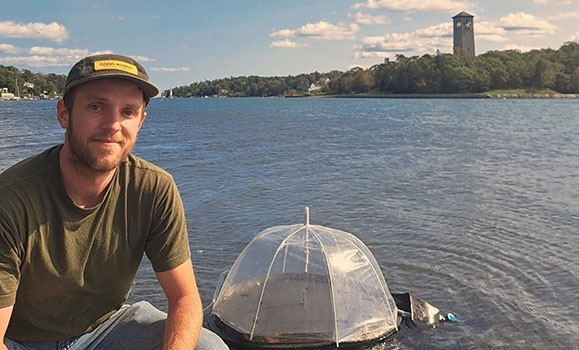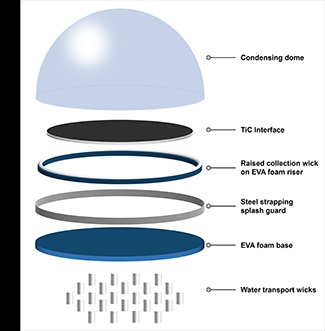
Dr. Matthew Margeson runs a test of a desalination device he conceptualized and developed in the Dasog Lab at Dalhousie. (Submitted photos)
"Water, water, everywhere, nor any drop to drink."
You've probably heard a variation of this line from the 1798 poem The Rime of the Ancient Mariner lamenting the fact that, despite its abundance, ocean water can't be consumed.
A lack of access to clean drinking water is a global problem, but a low-cost, portable water desalination device powered by solar energy developed by Dalhousie University researchers could help combat water scarcity in developing countries or remote areas.
Findings about the testing of a floating solar still that can both desalinate water and generate thermoelectricity were recently published in the open access iScience journal.
There are plenty of factors that make the Dal team's device unique, but key among them is that its design centres around a far humbler component than competing devices made with precious metals. The secret ingredient: used tires.
The idea for the solar still stemmed from refractory plasmonics, a field that aims to develop thermally and chemically stable nanomaterials that can manipulate light in special ways under harsh conditions.
"Refractory plasmonic nanomaterials are very good at capturing light and converting that light into heat," says Dr. Mita Dasog, an associate professor of chemistry and Killam Memorial Chair whose research group explores potential applications of this technology.
Dal Solutions
Learn more: Breakthrough poised to transform wastewater treatment worldwide
A device is born
Dr. Dasog was a lead author on the iScience journal paper along with postdoctoral fellow Dr. Matthew Margeson (PhD'24) and former undergraduate lab member Mark Atwood (BSc'23).
As a PhD student, Dr. Margeson conceptualized and developed the floating still prototype with the intention of overcoming challenges faced by previous designs, such as minimizing thermal losses, preventing salt buildup, and withstanding wind, waves, and changing weather conditions.

After placing the device in water, results can be seen almost instantly. A wicking system brings ocean water up to the foam surface of the device, where it's evaporated by solar-heated plasmonic materials. With the salt left behind, the water recondenses on the clear plastic dome over the top of the device and is funneled down the sides where it's collected in a sealed bag.
Real-world testing in Halifax Harbour resulted in daily water yields of up to 3.67 litres, a record-breaking amount for a passive floating solar still. The still can simultaneously desalinate, disinfect, and decontaminate the water at a cost of less than one cent per litre, making it incredibly cost efficient.
"Maximizing the use of sunlight means our plasmonic solar still can generate large amounts of water while maintaining a simple design," says Dr. Margeson. "It's exciting to showcase the effectiveness of the still on a real-world scale and prove that this type of device has the potential to bring freshwater to places that desperately need it."
The device can also be modified to generate a small amount of thermoelectricity, which Drs. Dasog and Margeson envision being enough to run on-board water quality sensors.
Turning trash into treasure
The most commonly-used plasmonic materials are precious metals like gold and silver, which are high-performing but expensive. For the solar still to be widely used in developing countries, it would need to be made with earth-abundant materials that would not compromise performance.
"We shouldn't be making an expensive or very complicated device," says Dr. Dasog. "It has to be easy to manufacture, last for a long time, and be easy to take apart and move."
A process known as pyrolysis, which involves heating carbon waste at high temperatures without oxygen, produces pyrolytic char that can be incorporated into plasmonic titanium carbides, effectively replacing expensive precious metals. In the floating desalination unit, a paper-thin layer of this material sits on the device's foam surface, keeping it away from cold ocean water and helping maximize heat localization.
Different types of carbon waste were sourced and tested, including coffee grounds, lobster shells, and birch wood residue, with tire rubber emerging as the best performer, as detailed in another recent research paper.
Given that tires are non-biodegradable, take hundreds of years to decompose in landfills, and are in abundant supply around the world, they represent a unique upcycling opportunity.
"This research perfectly aligns with the theme of Circular Economy Month by turning used tires into a crucial component of a water desalination device," adds Dr. Dasog.
Combating water scarcity
Next summer, the researchers plan to conduct further testing in South Asia, with the hope that eventually the device can be made available across the world.
Dr. Dasog, who earlier this year was nominated for the Emerging Leader award at the Water Canada Summit, says that whether because of war or climate change, communities forced to move from place-to-place struggle to access resources, so a portable device that can generate clean drinking water from the ocean could offer a lifeline.
"Water is such a basic requirement for survival, so our hope is to be able to help communities like these."












